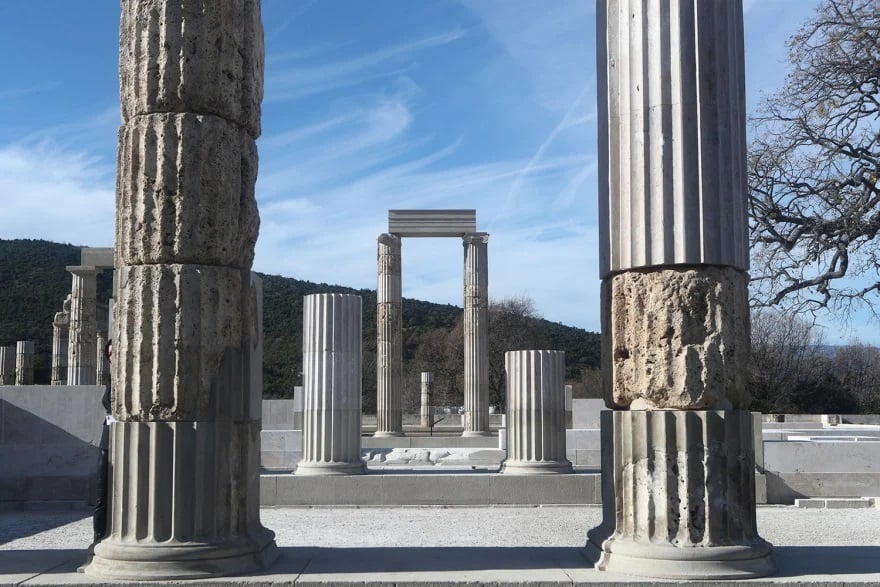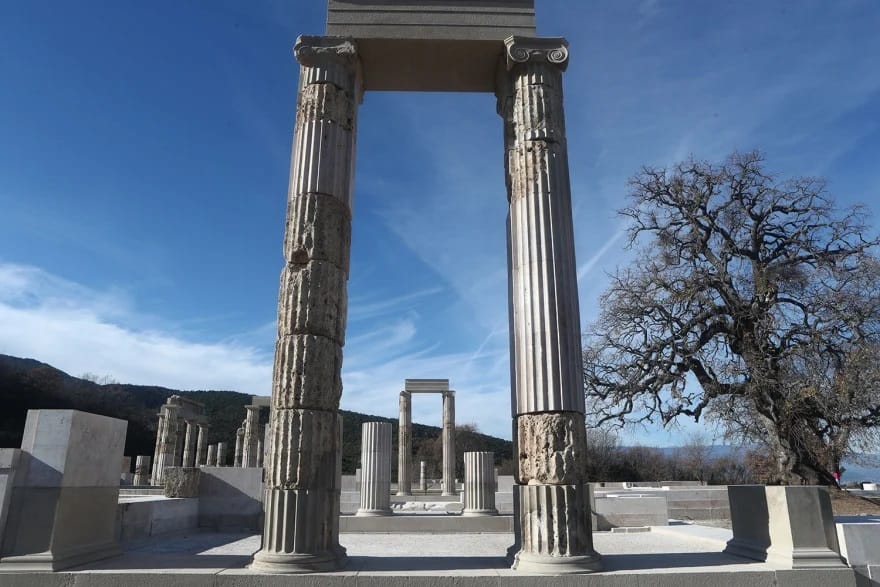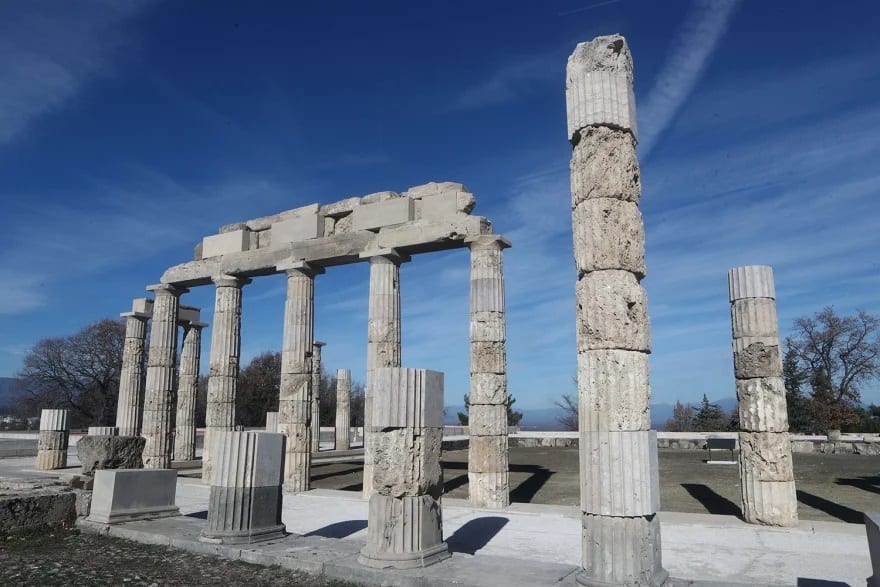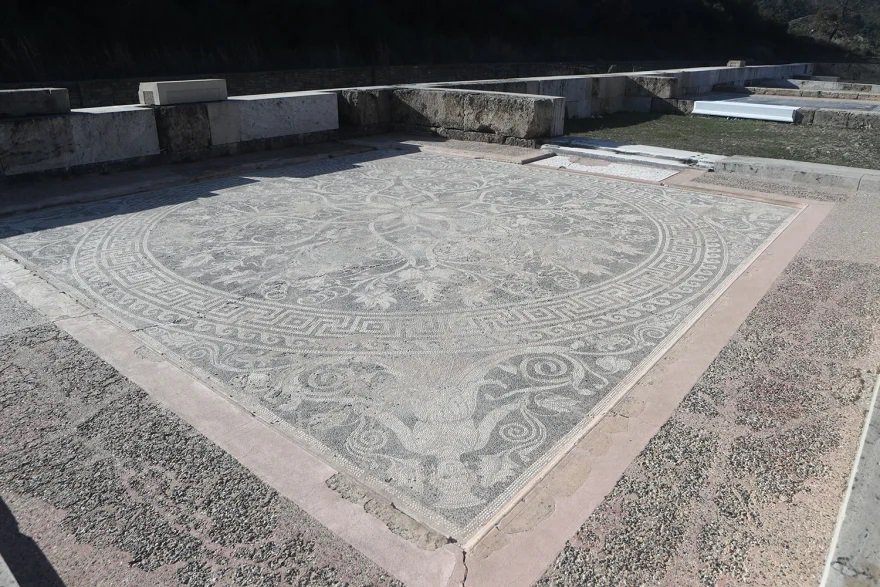A series of impressive photos from the restored palace of Philip II in Aigai came to light shortly before the opening of the archaeological site by Prime Minister Kyriakos Mitsotakis.
After 16 years of restoration, maintenance, fixing, restoration, excavation and documentation of the enormous technical work, the largest building seen in classical antiquity, what Professor Wolfram Hoepfner had described as the "Macedonian Parthenon" and in which the Parthenon fits three times, the Archaeological Site of Aigai was inaugerated.
At 1 pm on Friday, in the presence of Kyriakos Mitsotakis, the recently restored palace of the Aigai was inaugurated with the Prime Minister guided by the Honorary Superintendent of Antiquities, Angeliki Kottaridis.
The Minister of Culture, Lina Mendoni, did not attend the opening, as planned, as she was diagnosed with Covid.
See the impressive photos from the restored palace:





The centrepiece of the great building program, with which Philip II (359-336 BC) modernised and upgraded Aigai, the royal metropolis of the Macedonians, is the palace. The "palace" of Aigai - with its ancient name - with an area of approx. 15,000 sq.m, was the largest building in classical Greece.
A simple and functional building and at the same time monumental and imposing, the archetypal edifice is characterised by the luxury of the materials, the ingenuity and perfection of the execution, the unexpected achievements of technology and, at the same time, the geometric purity of the form that forms an ensemble of incomparable tranquillity, elegance and harmony, where everything is subordinated to the charm of measure.





With the monumental propylon, which evokes a sanctuary, the impressive two-story arcades of the facade that open to the city and invite citizens to make use of their space, the mega peristyle, around which the banqueting areas are organised, the dome, which, according to the epigraphs was a sanctuary of Patrous Herakles, the library/archive and the smaller western peristyle that served auxiliary uses (palaestra etc.) the "palace" foundation housed all those structures that were necessary for the exercise of multi-level public authority.
With 16 Doric columns on each side, the mega peristyle of Aigai, which epitomises the concept of the square, is the first of its kind. Having an area of 4,000 square metres, it could accommodate at least 8,000 people and function as a gathering place for Macedonians.
The gathering place of citizens takes on the image of a courtyard, and the word "courtyard" becomes synonymous with the concept of royalty.





The most brilliant building of Macedonia opens its gates to the world to remind some of its glorious moments:
- Its erection in the middle of the 4th BC. Century by Philip II to define the image of the new world... "I, the ruler, and my people coexist in this building, the palace of the Aigai", he had said, justifying the idea that led him to create the city and the palace.
- There, he organised and reformed the Macedonian kingdom and prepared the ground for what happened next with his son Alexander, who established the Hellenic World.
- Alexander the Great was proclaimed king there in 336 BC, after the assassination of his father. The same columns the visitor sees today are the ones that witnessed the Macedonians triumphantly striking their shields with their spears as they rhythmically called out his name.
- Starting from the same point, just two years later, was the beginning of the campaign of Alexander the Great to the depths of the East, where, together with the tens of thousands of hoplites and horse riders, they carried with them to the edge of the world the image of classical Greece, of Macedonia, of Aigai.
In a video published four years ago on the official YouTube account of the NSRF in Greece, the director of the Ephorate of Antiquities of Imathia, Mrs Angeliki Kottaridis, spoke about the building, which is considered to be of equal importance to the Parthenon and the efforts being made for its restoration.
"The palace is three times larger than the Parthenon in area (about 12,000 sq.m.) and is the work of a great architect of the 4th century BC, without excluding Pytheos. It functioned as an administrative centre and was a model for the palaces of the Hellenistic territory,” she said.
Watch a video of the site tour during the restorations:
READ MORE: Mystery Solved: Ancient Sphinx Inscription Reveals “Unusual” Poem in archaic Greek alphabet.
